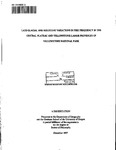LATE-GLACIAL AND HOLOCENE VARIATIONS IN FIRE FREQUENCY IN THE CENTRAL PLATEAU AND YELLOWSTONE-LAMAR PROVINCES OF YELLOWSTONE NATIONAL PARK
| dc.contributor.author | HOOPER MILLSPAUGH, SARAH | |
| dc.contributor.other | School of Geography, Earth and Environmental Sciences | en_US |
| dc.date.accessioned | 2013-10-09T11:20:17Z | |
| dc.date.available | 2013-10-09T11:20:17Z | |
| dc.date.issued | 1997 | |
| dc.identifier | NOT AVAILABLE | en_US |
| dc.identifier.uri | http://hdl.handle.net/10026.1/2120 | |
| dc.description.abstract |
The fire history in two geovegetation provinces in Yellowstone National Park was reconstructed to determine relations between postglacial climate change, fire frequency, and vegetation. Fire reconstructions were based on charcoal preserved in lake-sediment cores from the Central Plateau and Yellowstone-Lamar Provinces, and fire-related erosional events were inferred from changes in sediment magnetism. The fire records were compared with pollen data and paleoclimatic reconstructions for the past 17,000 years. In the Central Plateau Province, infertile soils restricted the vegetation response to Holocene climate changes, but fire frequency changed continuously as a result of variations in the intensity of summer drought. Fire frequency was highest (ten to 15 events/1000 years) when summer temperatures were high and effective precipitation was low in the early Holocene (ca. 10,000 cal yr BP). These conditions were caused by greater-than-present summer insolation and the expansion of die eastern Pacific subtropical high pressure system, which affected temperature and moisture conditions in the southern and central part of Yellowstone National Park. After 8000 cal yr BP, fire incidence decreased to present frequencies (two to three events/1000 years). The trend towards fewer fires coincided with decreasing summer insolation and cooler, effectively wetter conditions than before. In the Yellowstone-Lamar Province, fire frequency was moderate (six to ten events/l000 years) in the early Holocene. Pollen data indicate that summers then were warmer and wetter as a result of stronger-than-present monsoonal circulation that brought increased precipitation to the northern part of Yellowstone National Park during the summer insolation maximum. In the last ca. 2000 years, xerophytic vegetation has increased in the Yellowstone-Lamar Province, and fire frequency reached its highest levels (12 to 17 events/1000 years). The contrast in the two fire histories suggests that fire regimes reflect variations in the intensity of summer drought that resulted from variations in the seasonal cycle of insolation. Fire regimes in both provinces have been non-stationary during the Holocene as fire frequency changed continuously with millennial-scale climate variations. Fire incidence has also changed on submillennial-time scales. Several ca. 500-year periods were characterized by high fire occurrence in both provinces, including the period from ca. 500-1000 cal yr BP, which corresponded with the Medieval Warm Period. | en_US |
| dc.language.iso | en | en_US |
| dc.publisher | University of Plymouth | en_US |
| dc.title | LATE-GLACIAL AND HOLOCENE VARIATIONS IN FIRE FREQUENCY IN THE CENTRAL PLATEAU AND YELLOWSTONE-LAMAR PROVINCES OF YELLOWSTONE NATIONAL PARK | en_US |
| dc.type | Thesis | |
| plymouth.version | Full version | en_US |
| dc.identifier.doi | http://dx.doi.org/10.24382/4195 | |
| dc.identifier.doi | http://dx.doi.org/10.24382/4195 |
Files in this item
This item appears in the following Collection(s)
-
01 Research Theses Main Collection
Research Theses Main


